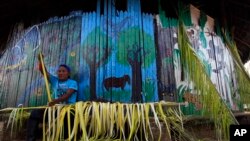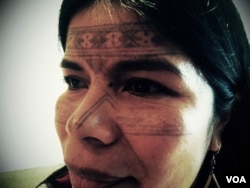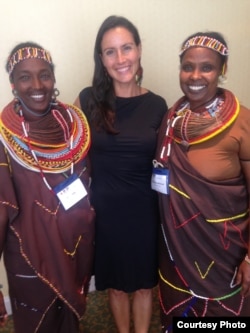There are thousands of indigenous cultures around the world. Relatively few of them, however, have the visibility and know-how needed to get the funding required to sustain their traditional ways of life, especially in light of increasing globalization and corporate acquisitiveness. But Evelyn Arce of International Funders for Indigenous Peoples is trying to change all that.
Smiling broadly, as she looked out at the colorfully dressed activists and their prospective funders at the World Summit on Indigenous Philanthropy that her small San Francisco-based non-profit had organized, Arce speaks with passion of building bridges between native peoples, donors and environmental groups.
“In the U.S., approximately 80,000 foundations give $27 billion a year to all kinds of projects,” she says. “But do you know how much goes to indigenous communities? Three-tenths of one percent. We know that 80 percent of the remaining biodiversity on Mother Earth is on indigenous territories. So if we care about environmental conservation and biodiversity, we need to bring indigenous peoples to the table,” says Arce.
The complex and artful patterning etched on Patricia Gualinga’s face identifies her as a Kichwa leader of her 1,200-member Sarayaku community in a remote region of the Amazon rainforest. The group is famous in Ecuador for its legal victory against oil companies that had been awarded a government concession to drill on their land.
Through an interpreter with Amazon Watch, an environmental group that helps support her work, Gualinga explained that more funds are needed to continue her people’s continued resistance.
“We have marches, we have mobilizations,” says she, adding that the Sarayaku also need funds for infrastructure.
“We could improve the conditions of our houses. We can improve the conditions of our pathways between communities, for example, [and for] alternative development projects.”
A river of giving that flows both ways
Pearl Gottschalk of Lush Cosmetics says she is constantly inspired by indigenous leaders like Patricia Gualinga who her company helps to support. Moments earlier, she complimented Gualinga on her long shiny black hair, which the leader then credited to a traditional ointment made from two local rainforest plants. Gualinga told her that her people call the plants "brother and sister" and that they were put on Earth and in her culture “to spread beauty.”
“And I thought, ‘that is exactly how we want to honor and respect the traditions of our first peoples around the world and how they view the plants,” says Gottschalk, “and how our company wants to bring that beauty to a modern world and to market to make the world smell and feel and look better. So we give money to them through charitable giving to help support their projects. That’s their voice, making solutions in their communities,” says Gottschalk.
The view that indigenous peoples, not outsiders, should decide their funding priorities echoes the philosophy of most funders at the summit. But it was the desire for political know-how as well as funding that brought Khun Kham Kaung, a leader from Myanmar’s Democracy for Ethnic Minorities Organization, to a Brooklyn hotel conference hall, where the World Summit on Indigenous Philanthropy was held.
"We have a lot of land grabbing issues and mega-projects, and mining projects and… a lot of our people are suffering from… negative impacts. Nobody helps us. That’s why I’m here. To try to understand the international community, how they can help,” said Kaung.
When asked what his organization would do with funding, Kaung is unequivocal.
"Our people in Myanmar, in Burma, are very uneducated, very illiterate. They don’t have the knowledge of politics and they don’t know democracy and they don't know human rights, [so] … it is very difficult for us to have their participation in activities. We will use the money training the people, to organize them," says Kaung.
The number of causes represented at the summit - from education to female empowerment and entrepreneurship, infrastructure improvement, maternal health and land tenure rights - were almost as diverse as the peoples themselves. As one observer remarked, “This is a small world, but with lots of big worlds inside.”







